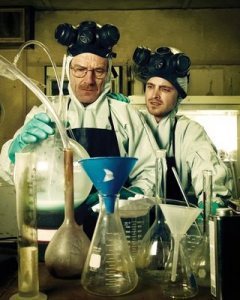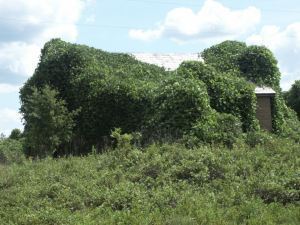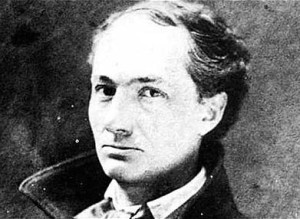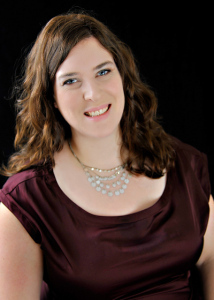National Poetry Month: Guest Post from Cassandra Rose Clarke: Poems Inspire Novels
I was asked to write this post because I am a novelist, but I keep wanting to come to it as a teacher. My day job is that of college instructor, and although the vast majority of the classes I teach are the dreaded (and required) freshman composition courses, I occasionally get to sneak some poetry into my lesson plans. I haven’t written poetry since college—like many authors, I dabbled in verse, then moved on to short stories and then finally novels, where I really found my comfort zone—but I still love to read it. I actually think all fiction writers should read poetry, because poetry, with its focus on rhythm and imagery and the economy of words, can teach us lessons about prose and—yes, I’m going to say it—storytelling that a thousand novels never could.

Chemistry!
With this post, I want to share and discuss some of the poems that have inspired and influenced me as a novelist. Most of them are contemporary poems, poems that I read on a whim—either while flipping through a class textbook, or by stumbling across them on the Internet—and all of them have taught me something about writing.
Chemistry Experiment by Bart Edelman
This poem tells a story through an extended metaphor. Even more brilliant is that, when you reach the end, you realize it has actually told you two stories: the literal one, about a classroom chemistry experiment going wrong despite the students following all the directions, and the underlying story, in which it’s not the chemistry experiment that has failed, but a relationship.
The best writing—whether poetry or prose or the script for a television show—is layered. In longer-form stories like novels and movies, this usually translates to external and internal plot. A crack team of mercenaries has to stop a ruthless killer from assassinating the President—external plot. The head of that team of mercenaries sees this as an opportunity for redemption—internal plot. Ideally, the external plot plays on the internal, and in the best cases you can go back and read the story over and over, finding new insights into the characters.
“Chemistry Experiment” does this, too, but as a poem, it’s condensed down, and the revelation about the internal plot is held off until the final lines:
And even now, years later,
When anyone still asks about you,
I get this sick feeling in my stomach
And wonder what really happened
To all the elementary matter.
The ending changes everything. This is not a poem about a run-of-the-mill almost-brush-with-death like I initially thought; it’s a poem about the connection between two people. I immediately reread it, and on second reading, with the knowledge of those final lines, I’m able to see the internal plot—arguably, the “real” plot—shining through. This sort of intense layering is necessary in a poem, where brevity is of the essence, but I’ve seen this technique applied to longer works (for a recent example, see the episode of Hannibal called “Su-zakana”) and it can create a depth and complexity that the usual external/internal interplay can’t quite get at.
Kudzu by Carley Rees Bogarad
This is another poem that utilizes that layering technique. In this case, we’re given information about kudzu: it grows in the American south, it covers and chokes out everything, in Japan it has an actual use. But again, the poem ends with a line that seemingly has nothing to do with kudzu:
In
a
dream
I watch you roll hot
against someone else’s skin.

Kudzu, the demon plant of the South!
Wait, what? I thought we were talking about kudzu, the demon plant of the south! But of course we never were. It’s a metaphor, the bread and butter of poetry. “Chemistry Experiment” is the same way, although the metaphor in that one does tell a recognizable story, with a beginning and an end. “Kudzu” tells a story too, but it’s not immediately recognized as such, since the discussion of kudzu is just that: a discussion. We’re presented with the image of kudzu, not just in the chosen words but in the layout of the poem—notice the typography above, one word on a line? The entire poem does this throughout, moving words from side to side, so that the words on the words on the page literally suggest the idea of kudzu crawling over the landscape. Once this image is seared in our mind, we’re given the point of comparison: sexual jealousy. There’s a story here, but it’s not told to us beat by beat, but in fragments of images. The narrator’s jealousy threatens to “choke and choke, leaving nothing alive.” With just the imagery of the poem, we’re able to deduce an entire narrative for this character. It’s a beautiful example of what reading ultimately is—an interaction between writer and reader—and it’s something that fiction writers should keep in mind.
One last thing: the poem’s trick of arranging the words to suggest kudzu is something that can be applied very effectively in longer writing as well. The seminal example, of course, is Mark Z. Danielewski’s House of Leaves, but you don’t necessarily need to go full postmodern to make use of the technique. A friend of mind once used it beautifully in a novel to show a character slipping down into unconsciousness.
La Beauté (Beauty) by Charles Baudelaire

Charles Baudelaire.
Charles Baudelaire, like Gabriel Garcia Marquez, was assigned reading for me in college. I’ve written a couple of posts lately about what a huge influence Garcia Marquez has been on my writing; however, I’ve not spoken as much about Baudelaire, despite his work, this poem especially, really inspiring me back when I was wee little writerling. I said earlier that I chose to discuss poems which taught me something about writing—that’s not entirely the case here, but I think it’s something just as important.
Reading Baudelaire piqued my interest in writing that was at once beautiful and dark. I don’t mean just in terms of the content, but in terms of the writing itself. I don’t read French, so I’m stuck with the translations, and I still vividly remember specific lines from the prose translations I read in college (I couldn’t find them online, unfortunately). In particular I loved the final line: “My eyes, my wide eyes, eternally bright!” It was the perfect blend of imagery and rhythm and it’s stuck with me all these years.
All writing—all storytelling—has the potential to stay with you. There are novels that I hold close to my heart the way I do La Beauté, but with poetry, I find I am rarely struck with the entire poem, but with pieces of it. In many ways poems showcase the power and strength of language in a way novels often don’t. I do the same thing with movies: certain images will stay with me long after the rest of the movie has faded. A professor once told me that writing a screenplay comes closest to writing poetry, and I can believe it. Both are caught up in rhythm and images and connecting disparate elements in a way that the reader can fill in the rest. Poetry gets a bad rap because people feel like they’ve been force-fed it during school, but I would argue that any writer should add a couple of poets to their TBR pile.

Caroline Rose Clarke. Photo by Brittany at Flashbox Shop.
Cassandra Rose Clarke grew up in south Texas and currently lives in a suburb of Houston, where she writes and teaches composition at a local college. She graduated in 2006 from The University of St. Thomas with a B.A. in English, and two years later she completed her master’s degree in creative writing at The University of Texas at Austin. In 2010 she attended the Clarion West Writer’s Workshop in Seattle, where she was a recipient of the Susan C. Petrey Clarion Scholarship Fund.
Cassandra’s first adult novel, THE MAD SCIENTIST’S DAUGHTER was a finalist for the 2013 Philip K. Dick Award, and her YA novel, THE ASSASSIN’S CURSE, was nominated for YALSA’s 2014 Best Fiction for Young Adults. Her short fiction has appeared in Strange Horizons and Daily Science Fiction.
Cassandra is represented by Stacia Decker of the Donald Maass Literary Agency.








